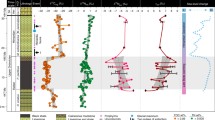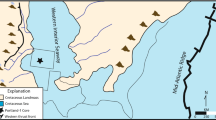Abstract
Studies show positive shifts of inorganic and organic carbon isotope values (δ13Ccarb and δ13Ckerogen) from +0.43 (‰ V-PDB) to +3.54 (‰ V-PDB) and from −29.38 (‰ V-PDB) to −24.14 (‰ V-PDB), respectively, B* (Ba* = Ba/ (Al2O3 × 15%)) values from 0.015 to 0.144, TOC values from 0.02% to 0.21%, V/Cr values from 0.3 to 2.0, Sr/Ba values from 3.20 to 49.50 in the Late Devonian Frasnian Upper rhenana zone to the top linguiformis zone of the Yangdi section deposited in carbonate slope facies of Guilin, Guangxi, South China, which indicates that biomass, productivity, organic carbon burial and salinity increase and that oxygenation near the boundary between sediments and waters decreases from the Late Devonian Frasnian Upper rhenana zone to the top linguiformis zone. Abundance of molecular fossils increases and normal alkanes, isoprenoid hydrocarbon, terpanes and steranes are dominated from the Late Devonian Frasnian to the bottom of Famennian, which shows that the predecessors of molecular fossils of the Frasnian-Famennian (F-F) transition are dominated by marine phytoplankton, zooplankton and benthic bacteria with no photosynthesis. Therefore, it is considered that the F-F transitional mass extinction with a multistage, selection and global synchronizing was caused by bacterial-algal proliferating, continuing deterioration of the shallow marine ecoenvironment of the middle-lower latitudes. A simple cause and effect chain can be expressed as: appearance of seed plants and multi-storied forests → enhanced chemical and biochemical weathering and pedogenesis → wide development of soils → increasing riverine nutrient fluxes in epicontinental sea → from superoligotrophic to eutrophic in epicontinental sea → proliferating of marine phytoplankton and zooplankton → frequent red tide and anoxia → mass extinction of shallow marine organisms in the middle-lower latitudes. It is worth notice that the factor drawdown of atmospheric \(P_{CO_2}\), climatic cooling and sea level falling caused by eutrophication, anoxia and organic carbon burial increasing may be important for the mass extinction.
Similar content being viewed by others
References
Gong, Y.-M., Significant geological events, rhythms and interaction of different earth-spheres, Earth Science Frontiers (in Chinese with English abstract), 1997, 4(3): 75–84.
Walliser, O. H., Global events in the Devonian and Carboniferous. (ed. Walliser, O. H.), Global Events and Event Stratigraphy, Berlin: Springer-Verlag, 1996, 225–250.
Hsu, K. J., Oberhansli, H., Gao, J. Y. et al., ‘Strangelove ocean’ before the Cambrian explosion, Nature, 1985, 809–811.
Wang, K., Orth, C. J., Attrep, M. et al., Geochemical evidence for a catastrophic biotic event at the Frasnian/Famennian boundary in South China. Geology, 1991, 19: 776–779. [DOI]
Gong, Y. M., Li, B. H., Wu, Y., An integrated study of carbon isotope and molecular stratigraphy in the Frasnian-Famennian transition of Guangxi, South China, Earth Science Frontiers (in Chinese with English abstract), 2002, 9(3): 151–160.
Summons, R. E., Jahnke, L. L., Hope, J. M. et al., 2-Methyl-hopanoids as biomarkers for cyanobacterial oxygenic photosynthesis, Nature, 1999, 400: 554–557. [DOI]
Yang, Q., A frontal area in palaeontology-molecular fossils studies, Acta Palaeontologica Sinica (in Chinese with English abstract), 1995, 34 (5): 265–276.
Macalady, J., Banfield, J. F., Molecular geomicrobiology: genes and geochemical cycling, Earth and Planetary Science Letters, 2003, 209: 1–17. [DOI]
Brassell, S. G., Eglinton, G., Maxwell, J. R. et al., Natural background of alkanes in the aquatic environment (eds. Hutzinger, O., Van Lelyveld, I. H., Zoeteman, B. C. J.), Aquatic Pollutants, Oxford: Pergamon Press, 1978, 69–86.
Mello, M. R., Telnaes, N., Gaglianone, M. I. Et al., Organic geochemical characterisation of depositional palaeoenvironments of source rocks and oils in Brazilian marginal basins, Organic Geochemistry, 1988, 13: 31–45. [DOI]
Freeman, K. H., Hayes, J. M., Trendel, J., M. et al., Evidence from carbon isotope measurements for diverse origins of sedimentary hydrocarbons, Nature, 1990, 343: 254–256. [DOI]
Sakata, S., Hayes, J. M., Mctaggart, A. R. et al., Carbon isotope fractionation associated with lipid biosynthesis by cyanobacteria: relevance for interpretation of biomarker records, Geochim. Cosmochim. Acta, 1998, 61: 53–89.
Murphy, A. E., Sageman, B. B., Hollander, D. J. et ak,m Black shale deposition and faunal overturn in the Devonian Appalachian basin: Clastic starvation, seasonal water-column mixing, and efficient biolimiting nutrient recycling, Paleoceanography, 2000, 15 (3): 280–291. [DOI]
Joachimski, M. M., Pancost, R. D., Freeman, K. H. et al., Carbon isotope geochemistry of the Frasnian-Famennian transition, Palaeogeography Palaeoclimatology Palaeoecology, 2002, 181: 91–109. [DOI]
Gong Yiming, Li Baohua, Si Yuanlan et al., The Late Devonian red tide and mass extinction, Chinese Science Bulletin, 2002, 47(13): 1138–1144.
Kerr, R. A., Mass extinctions face downsizing, extinction, Science, 2001, 293: 1037. [DOI]
Copper, P., Reef development at the Frasnian/Famennian mass extinction boundary, Palaeogeography Palaeoclimatology Palaeoecology, 2002, 181: 27–65. [DOI]
Chen, D. Z., Tucker, M. E., The Frasnian-Famennian mass extinction: insights from high-resolution sequence stratigraphy and cyclostratigraphy in South China, Palaeogeography Palaeoclimatology Palaeoecology, 2003, 193: 87–111. [DOI]
Kaufman, A. J., Knoll, A. H., Neoproterozoic variations in the C-isotope composition of seawater: stratigraphic and biogeochemical implications, Precambrian Research, 1995, 73: 27–49. [DOI]
Gong, Y. M., Si, Y. L., Xu, G. H. et al., Late Devonian phosphatic microspherules-possible oocytes, Acta Geologica Sinica (in Chinese with English abstract), 2001, 75(4): 441–445.
Yan, Z., Hou, H. F., Ye, L. F., Carbon and oxygen isotope event markers near the Frasnian-Famennian boundary, Luoxiou section, South China, Palaeogeography Palaeoclimatology Palaeoecology, 1993, 104: 97–104. [DOI]
Bai, S. L., High Resolution Correlation, Milankovitch Cyclicity, and Nickel Event—Evidence From the Devonian of South China, Beijing: Peking University Press, 1995, 1–62.
Bai, S. L., Chemo-biostratigraphic study of the Devonian Frasnian-Famennian event, Acta Sci. Nat. Univ. Pekinensi (in Chinese with English abstract), 1998, 34 (2–3): 363–369.
Zheng, Y. F., Chen, J. F., Geochemistry of Stable Isotopes (in Chinese), Beijing: Science Press, 2000, 1–316.
Hou, H. F., Muchez, P., Swennen, R. et al., The Frasnian-Famennian event in Hunan province, South China: biostratigraphical, sedimentological and geochemical evidence, Mem. Inst. Geol. Univ. Louvain, 1996, 36: 209–229.
Chen, D. Z., Tucker, M. E., Shen, Y. et al., Carbon isotope excursions and sea-level change: implications for the Frasnian-Famennian biotic crisis, Journal of the Geological Society, London, 2002, 159: 623–626.
Xu, B., Gu, Zh.-Y, Liu, Q. et al., Carbon isotopic record from Upper Devonian carbonates at Dongcun in Guilin, southern China, supporting the worldwide pattern of carbon isotope excursions during Frasnian-Famennian transition, Chinese Science Bulletin, 2003, 48(12): 1265–1274.
Joachimski, M. M., Buggisch, W., Anoxic event in the late Frasnian—cause of the Frasnian-Famennian faunal crisis? Geology, 1993, 21: 675–678. [DOI]
Wang, K., Geldsetzer, H. H. J., Goodfellow, W. D. et al., Carbon and sulfur isotope anomalies across the Frasnian-Famennian extinction boundary, Albert, Canada, Geology, 1996, 24: 187–191. [DOI]
Stephens, N. P., Sumner, D. Y., Late Devonian carbon isotope Stratigraphy and sea level fluctuations, Canning Basin, Western Australia, Palaeogeography Palaeoclimatology Palaeoecology, 2003, 191: 203–219. [DOI]
Joachimski, M. M., Comparison of organic and inorganic carbon isotope patterns across the Frasnian-Famennian boundary, Palaeogeography Palaeoclimatology Palaeoecology, 1997, 132: 133–145. [DOI]
Holser, W. T., Magaritz, M., Ripperdan, R. L., Global isotopic events (ed. Walliser, O. H), Global Events and Event Stratigraphy, Berlin: Springer-Verlag, 1996, 63–87.
Sephton, M. A., Amor, K., Franchi, L. A. et al., Carbon and nitrogen isotope disturbances and an end-Norian (Late Triassic) extinction event, Geology, 2002, 30: 1119–1122. [DOI]
Racki, G., Racka, M., Matyja, H. et al., The Frasnian-Famennian boundary interval in the South Polish-Moravian shelf basins: integrated event-stratigraphical approach, Palaeogeography Palaeo-climatology Palaeoecology, 2002, 181: 251–297. [DOI]
Gong, Y. M., Xu, R., Tang, Zh. D. et al., The Upper Devonian orbital cyclostratigraphy and numerical dating conodont zones from Guangxi, South China, Science in China, Series D, 2005, 48(1): 32–41.
Wang, Cheng-yuan, Ziegler, W., Frasnian/Famennian conodont mass extinction and recovery in South China, Senckenbergiana Lathaea, 2002, 82(2): 463–496.
Gong, Y.-M., Yin, H.-F., Tong, J.-N., Outline on global environmental changes symposium of the geological historical overturn periods, Geological Science and Technology Information (in Chinese with English abstract), 1998, 17(4): 101–106.
Li, Y. X., Famennian tentaculitids of China, Journal of paleontology, 2000, 74 (5): 969–975.
Ji, Q., On the Frasnian-Famennian extinction event in South China as viewed in the light of conodont study, Collected Papers of Stratigraphy and Palaeontology (in Chinese with English abstract), 1994, 24: 79–107.
Sepkoski, J. J., Phanerozoic overview of mass extinctions, Patterns and Processes, In The History of Life (eds. Raup, D. M., Jablonski, D.), Berlin: Springer-Verlag, 1986, 277–295.
McGhee, G. R., The Late Devonian Mass Extinction: The Frasnian-Famennian Crisis, New York: Columbia University Press, 1996, 1–327.
Droser, M. L., Bottjer, D. J., Sheehan, P. M. et al., Decoupling of taxonomic and ecologic severity of Phanerozoic marine mass extinctions, Geology, 2000, 28(8): 675–678. [DOI]
Hallam, A., Wignall, P. B., Mass Extinctions and Their Aftermath, Oxford: Oxford University Press, 1997, 1–320.
Racki, G., The Frasnian-Famennian biotic crisis: How many (if any) bolide impacts? Geol. Rundsch, 1999, 87: 617–632. [DOI]
Liao, W. H., Biotic recovery from the Late Devonian F-F mass extinction event in China, Science in China, Series D, 2002, 45(4): 380–384.
Guo, Sh. Zh., The Frasnian-Famennian transitional bioevents and Late Devonian corals in Great Khingan Ranges, Northeastern China, Acta Palaeontologica Sinica (in Chinese with English abstract), 1990, 29(4): 427–433.
Algeo, T. J., Scheckler, S. E., Terrestrial-marine teleconnections in the Devonian: link between the evolution of land plants, weathering processes, and marine anoxic events, Philosophical Transactions of Royal Society of Lond, 1998, B353: 113–130.
Soreghan, G. S., Soreghan, M. J., Atmospheric dust and algal dominance in the Late Paleozoic: a hypothesis, Journal of Sedimentary Research, 2002, 72(4): 457–461.
Martin, R., Secular increase in nutrient level through the Phanerozoic: Implications for the productivity, biomas, and diversity of the marine biosphere, Palaios, 1996, 11: 209–219.
Stephens, N. P., Sumner, D. Y., Famennian microbial reef facies, Napier and Oscar Ranges, Canning Basin, western Australia, Sedimentology, 2003, 50(6): 1283–1302. [DOI]
Shen, J. W., Webb, G. E., Famennian (Upper Devonian) calcimicrobial (Renalcis) reef at Miaomen, Guilin, Guangxi, South China, Palaeogeography Palaeoclimatology Palaeoecology, 2004, 204(3–4): 373–394. [DOI]
Jackson, J. B. C., Johnson, K. G., Measuring past biodiversity, Science, 2001, 293: 2401–2403. [DOI]
Author information
Authors and Affiliations
Corresponding author
Rights and permissions
About this article
Cite this article
Gong, Y., Xu, R., Tang, Z. et al. Relationships between bacterial-algal proliferating and mass extinction in the Late Devonian Frasnian-Famennian transition: Enlightening from carbon isotopes and molecular fossils. Sci. China Ser. D-Earth Sci. 48, 1656–1665 (2005). https://doi.org/10.1360/02yd0346
Received:
Revised:
Published:
Issue Date:
DOI: https://doi.org/10.1360/02yd0346




